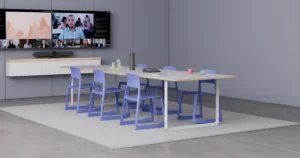Education not only changes lives for the young, but also for adults who are looking to upgrade their current skill sets or to learn new ones in preparation for a career change. With technology advancements, getting online via a smart device or computer is a given in many parts of the world. This means that educators and training institutes can deliver their curriculum online, anytime and anywhere, without the restriction of a fix physical location.
In this fast moving digital era and in the face of a global pandemic, classes and training delivering online are not only a necessity but the new reality.
Question : Is video conferencing effective for education and virtual learning?
To answer this question, we have to look at how teaching are being delivered in physical classrooms now and compare that to a class that is being delivered online.
Size of the class
Typical class size may be around 15 to 30 students ; the number of students in a class are (1) limited by the physical size of the classrooms and (2) dependent on how much the school or training entity emphasize on the level of engagement between teachers and students ie. the bigger the class, the less time a teacher or instructor can engage each student.
From the online class perspective, depending on the course requirements, the number of students can vary between a couple to thousands who can then consume the course materials via live remote teaching or reviewing the class from a recorded stream at the student’s convenience.
Not to mention that everyone have more time for productive work as there’s no need to travel just to attend the class.
Class interactivity
Can an online class be able to support the level of engagement required between the instructor and students for effective learning? The answer is a resounding “YES”. Current video collaboration platforms support features like raise hands, polling, chat and of course direct video interaction between the student and instructor. The level of class interactivity can be moderated by the instructor accordingly and one super feature is “Mute All” which is a really practical feature to keep disturbances at a minimum.
Instructors can share course content easily as well as do annotations and whiteboard feature for better visualisation; which makes it no different from a physical class environment.
A super cool feature is that you can enable small group discussion by assigning students to random or designated breakout rooms where they can engage with a topic at a deeper level, just like in a physical classroom.
The video conference solution integrates with Canvas, a leading online learning management platform as well.
Video and Audio Quality
Nothing beats being in a physical class and having face to face interactions. Hence the quality of the video and audio in a virtual class will determine how good the students and teachers’ experience will be.
We have an online solution that let the class hear each other without distractions with Dolby Voice® noise suppression as their unique Audio offering combine with HD video. We have another that offers 4K video quality and 4K content sharing to support curriculum which are detail-oriented so that everyone in the class will not miss a thing.
So you may ask about the cost of achieving a really strong video and audio setup for online classes; short answer is that it will be less than what you pay for in rental of your physical classrooms on an annual basis.

Technology advancement and the virus pandemic have accelerated the adoption of virtual learning for educators, training institutes and students alike. Online classes will work hand in hand with physical classes to deliver an all rounded, immersive and interactive curriculum to eager learners globally.



